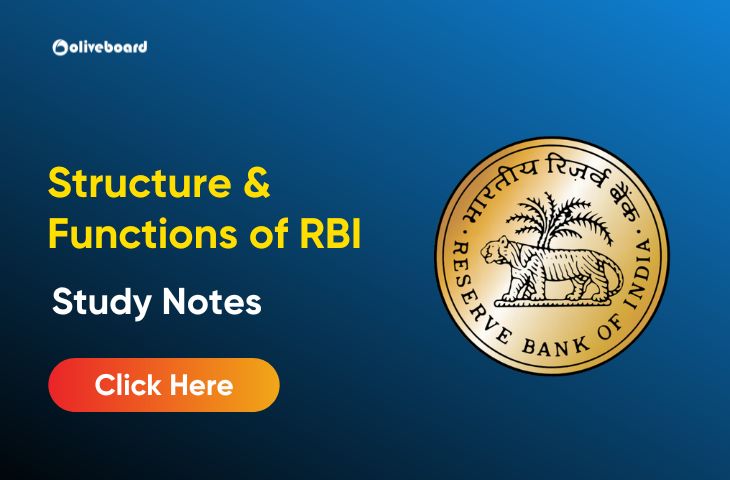Structure & Functions of RBI
Structure of RBI – The Reserve Bank of India (RBI) is the central bank of India and the regulatory body who is responsible for the regulation of the Indian Banking System. RBI works to promote economic development in the country by managing the country’s main payment systems. Every aspirant who is preparing for banking and regulatory exams must know about the Structure & Functions of RBI in detail, so go through the complete blog.
Structure & Functions of RBI – Complete Notes
Before moving on to the Structure & Functions of RBI, let us know what is RBI, when was RBI established, where was RBI’s first central office, what does central office refers to, when RBI’s office was shifted to Mumbai, etc.
Download Summary of RBI Annual Report
Reserve Bank of India (RBI)
Let’s check out the answers to the above RBI related questions in the following pointers:
- The RBI was established on April 1, 1935, in accordance with the provisions of the RBI Act, 1934.
- The Central Office of the RBI was initially established in Kolkata but then it was permanently moved to Mumbai in the year 1937.
- The Central Office is where the Governor sits and where policies are formulated.
- RBI was nationalized in 1949 and since then it has been fully owned by the Government of India (GOI).
Structure of RBI
We have shared the complete Structure of RBI below. Also know that every year, RBI Grade B Notification is released wherein candidates can fill up the forms, and sit for the exam. If the candidate clears all three phases of the selection process, then he/she is selected as RBI Grade B Officer.
Download 100+ Important Economic & Finance Terms Ebook
RBI Structure: Central Board
The Reserve Bank’s affairs are governed by a central board of directors. The Central Board of Directors is the apex body in the governance Structure of RBI. There are also four Local Boards for the Northern, Southern, Eastern, and Western areas of the country which take care of local interests. The central government appoints/nominates directors to the Central Board and members to the Local Boards in accordance with the Reserve Bank of India (RBI) Act. The composition of the Central Board is enshrined under Section 8(1) of the RBI Act, 1934. The Central Board consists of:
- The Governor
- 4 Deputy Governors of the Reserve Bank
- 4 Directors nominated by the central government, one from each of the four Local Boards as constituted under Section 9 of the Act
- 10 Directors nominated by the central government
- 2 government officials nominated by the central government
Download RBI Grade B 2024: The Complete Guide Here
The Central Board is assisted by three committees:
- The Committee of the Central Board (CCB)
- The Board for Financial Supervision (BFS)
- The Board for Regulation and Supervision of Payment and Settlement Systems (BPSS)
Organisational Structure of RBI
The organisational structure of RBI is given below. Also, do not forget to download the PDF of orgranistational structure.
Support Staff> Assistant Manager> Manger> Assistant General Manager> Deputy General Manager> General Manager> Chief General Manager> Principal Chief General Manager> Executive Directors> Deputy Governors> Governor
Download Organisational Structure of RBI
Functions of RBI
Check out the below-given points to know the Functions of RBI in detail:
- Monetary Authority: The Reserve Bank of India being the central bank of the country is the monetary authority of India and the sole authority vested with the power to issue currency notes, regulate the supply of currency and credit in the economy to secure monetary and price stability.
- Regulate & Supervise Financial Stability and Financial Inclusion: It is also the responsibility of RBI to regulate & supervise the banking sector with an eye on securing financial stability and financial inclusion.
- Currency Management: Currency Management is the process of managing the life cycle of the notes, which includes:
- Assessing the printing requirement of various denominations of notes,
- Placing indents with the note printing presses,
- Supplying and distributing adequate quantities of currency throughout the country
- Ensuring the quality of banknotes in circulation by a continuous supply of clean notes and timely withdrawal of soiled notes.
Section 23 of the RBI Act, 1934 mandated that the function of issuance of banknotes (above 1 Rupee) is to be conducted by the RBI through a separate department called the Issue Department.
- Foreign Exchange Management: The Reserve Bank oversees the foreign exchange market in India. It supervises and regulates it through the provisions of the Foreign Exchange Management Act (FEMA), 1999.
- Banker to Banks: RBI also act as a banker to banks and Governments by maintaining their accounts and carrying out transactions on their behalf as well as providing them banking services.
- Banker to Government: Managing the Government’s banking transactions is one of the key functions of the RBI. Like individuals, businesses and banks, Governments too need a banker to carry out their financial transactions in an efficient way, including the raising of resources from the public. Since its inception, the RBI has undertaken the traditional central banking function of managing the Government’s banking transactions. The central bank also serves as an agent and adviser to the Government.
- Regulate and Supervise the Financial System: Financial system in India is carried out by different regulatory authorities. The Reserve Bank regulates and supervises the major part of the financial system. The supervisory role of the Reserve Bank involves commercial banks, Urban Co-operative Banks (UCBs), certain Financial Institutions (FIs) and Non-Banking Financial Companies (NBFCs). Some of the FIs, in turn, regulate and/or supervise other institutions in the financial sector.
Download 120+ Management MCQs Ebook
In addition to these, the Reserve Bank of India also represents India at the International Monetary Fund (IMF), promotes the growth of the economy, acts as a lender of last resort to commercial banks, strengthens and supports small local banks, and encourages banks to open branches in rural areas, publish economic data, etc.
Current Governor of RBI
Shri Shaktikanta Das, IAS Retd., former Secretary, Department of Revenue and Department of Economic Affairs, Ministry of Finance, Government of India assumed charge as the 25th Governor of the Reserve Bank of India effective December 12, 2018.
Structure & Functions of RBI – Sample Questions
Q. Which of the following is not the function of RBI?
- Banker to banks and Government, lender of the last resort
- Credit Management
- Accepting deposits and making loans from public
- Regulating Currency
- None of the above
Answer: Accepting deposits and making loans from public
Q. When was the Reserve Bank of India nationalized?
- 1935
- 1947
- 1948
- 1949
- 1960
Answer: 1949
RBI Grade B Preparation Material – Free Ebooks
Hey aspirants!! We have specifically kept this section for the free ebooks. Here, you will get all the topic-wise ebooks. We will keep on updating fresh and new ebooks on different topics so do not forget to bookmark this blog. To download this ebook, all you need to do is log in. Also, download RBI Grade B Memory-Based Papers below:
- Download RBI Grade B GA Answer Key
- Get RBI Grade B ESI & FM Objective Questions Answer Key
- Download RBI Grade B ESI & FM Descriptive Questions Answer Key
Download FREE Ebooks on Government Schemes for all Regulatory Exams: IRDAI, RBI, NABARD, SIDBI, SEBI, IFSCA
- Final Revision of Important Govt Schemes for RBI Grade B
- Top 10 Govt Schemes from Ministry of Agriculture: Part 1
- Top 10 Govt Schemes from Ministry of Agriculture: Part 2
- Top 5 Government Schemes From the Ministry of Education
- Top 6 Govt. Schemes from the Ministry of Finance
- Top 5 Initiatives of NITI Aayog
FREE Ebooks on General Awareness, ESI, FM & Miscellaneous Topics for all Regulatory Exams: IRDAI, RBI, NABARD, SIDBI, SEBI, IFSCA – Download
The syllabus of all the regulatory exams is somewhat similar, so practicing and learning from other exam-specific ebooks are also beneficial in the preparation. Here, we have compiled all the latest ebooks that will help you ace the exam.
- Download RBI Annual Report Important MCQs: Part 1
- Download RBI Annual Report Important MCQs: Part 2
- Top 50 Banking & Finance CA for all Regulatory Exams
- Top 100 PIB Current Affairs MCQs for RBI Grade B: Part 1
- Top 100 PIB Current Affairs MCQs for RBI Grade B: Part 2
- Introduction to Management
- Five-Year Plans
- Indian Agriculture
- Insurance Sector in India
- International Economic Institutions
- Export-Import Policy
Download FREE Ebooks on QRE (Quantitative Aptitude, Reasoning, English) for all Regulatory Exams: IRDAI, RBI, NABARD, SIDBI, SEBI, IFSCA
Download all the ebooks for FREE and enhance your preparation.
Quantitative Aptitude Ebooks
- Top 50 Quants Questions for IRDAI Assistant Manager
- Top 25 Number Series Questions for RBI Grade B
- Most Repetitive Quants Questions for RBI Grade B
Reasoning Ebooks
- Top 50 Reasoning Questions for IRDAI Assistant Manager
- Most Repetitive Reasoning Questions for RBI Grade B
- Top 25 Puzzle Questions for RBI Grade B
- Top 25 Syllogism Questions for RBI Grade B
English Language Ebooks
- Top 50 English Questions for IRDAI Assistant Manager
- Most Repetitive English Questions for RBI Grade B
- Top 25 Subject Verb Agreement Questions for RBI Grade B
- Top 20 Para Jumble Questions for RBI Grade B
- Top 100 Idioms & Phrases for RBI Grade B
- Top 135 One-Word Substitutions for RBI Grade B
Preparing for Regulatory Exams? Need regular updates of CA, Notifications, Free Ebooks, YT Sessions, and More, then Join Our Regulatory Whatsapp Channel.
If you are preparing for Regulatory Exams, then do not forget to check out all the blogs on the regulatory exams. Check Regulatory Exam Blogs.
Get Daily FREE Material for RBI Grade B, NABARD Grade A, SEBI Grade A, IFSCA Grade A, and SIDBI Grade A, IRDAI Assistant Manager – Join Oliveboard’s Regulatory Exam Telegram Channel
Check out all the videos for RBI Grade B, NABARD Grade A, SEBI Grade A, IFSCA Grade A, and SIDBI Grade A, IRDAI Assistant Manager- Subscribe to Oliveboard’s Regulatory Exam Youtube Channel
- PFRDA Grade A Apply Online 2025 for Assistant Manager Post

- PFRDA Grade A Notification 2025 Released for 40 Vacancies

- CCI Last Minute Revision Plan for 8th July 2025, Check Tips

- Effective Study Strategies for the PFRDA Grade A Statistics

- PFRDA Grade A Lifestyle in 2025, Their Growth and Benefits

- PFRDA Grade A Exam Date 2025, Check Complete Exam Schedule


Hello there! I’m a dedicated Government Job aspirant turned passionate writer & content marketer. My blogs are a one-stop destination for accurate and comprehensive information on exams like Regulatory Bodies, Banking, SSC, State PSCs, and more. I’m on a mission to provide you with all the details you need, conveniently in one place. When I’m not writing and marketing, you’ll find me happily experimenting in the kitchen, cooking up delightful treats. Join me on this journey of knowledge and flavors!
